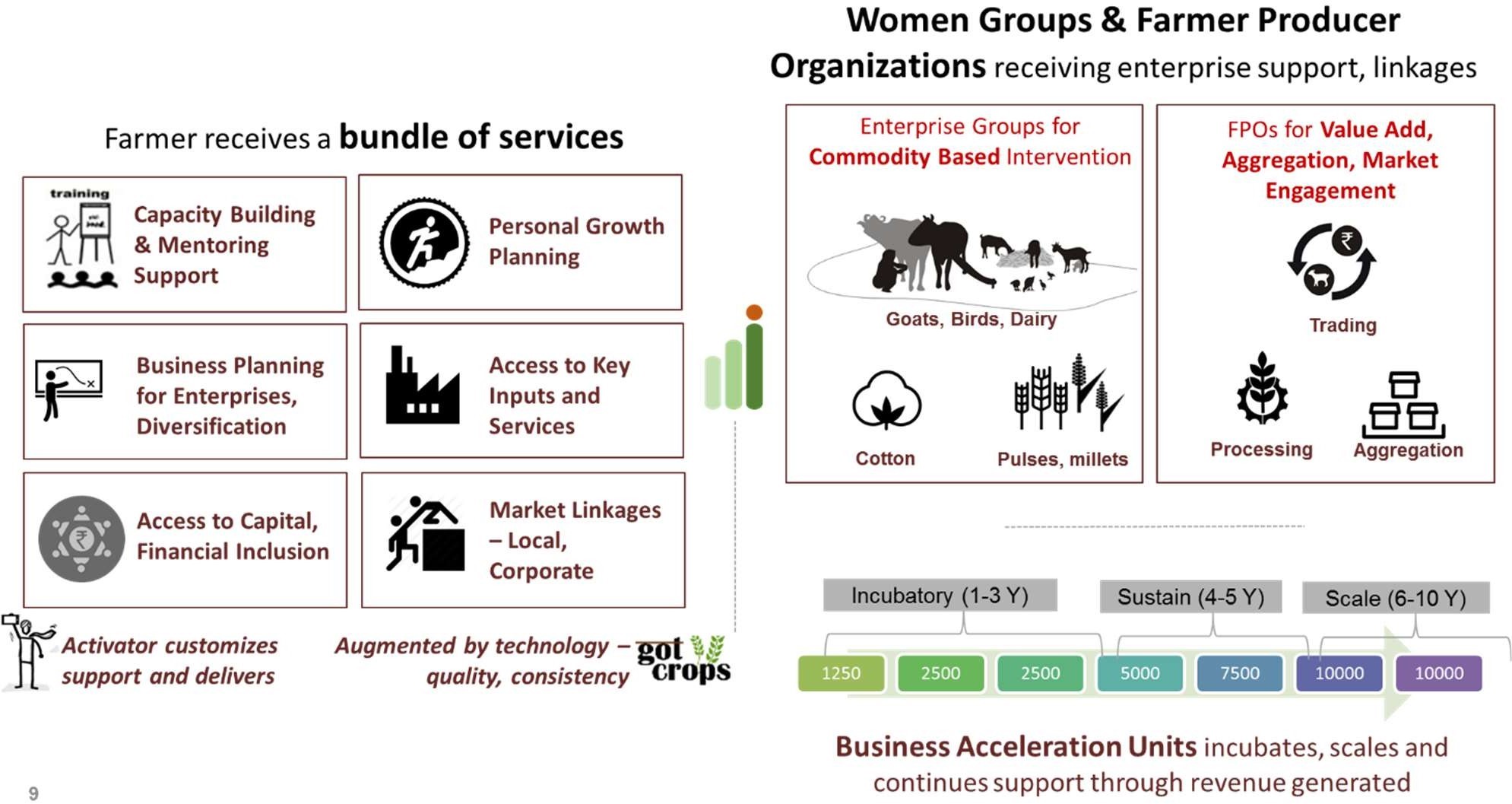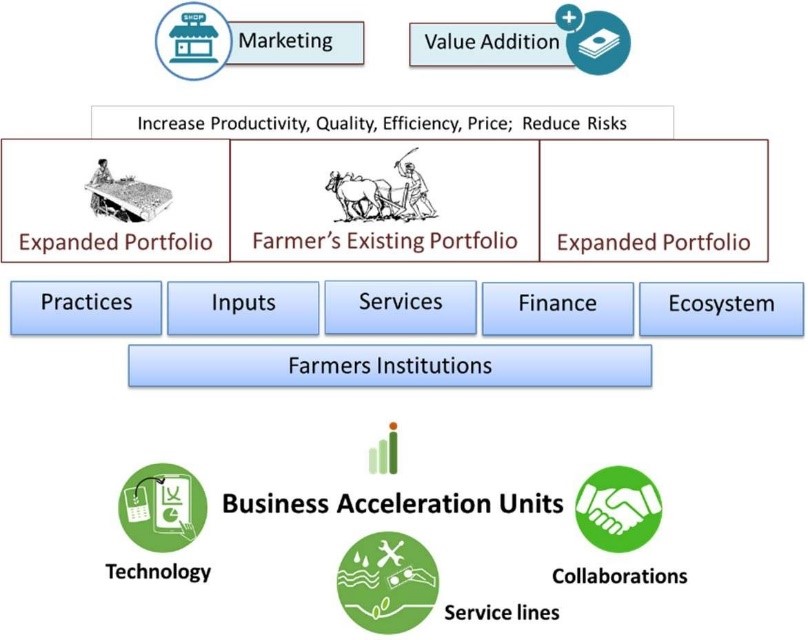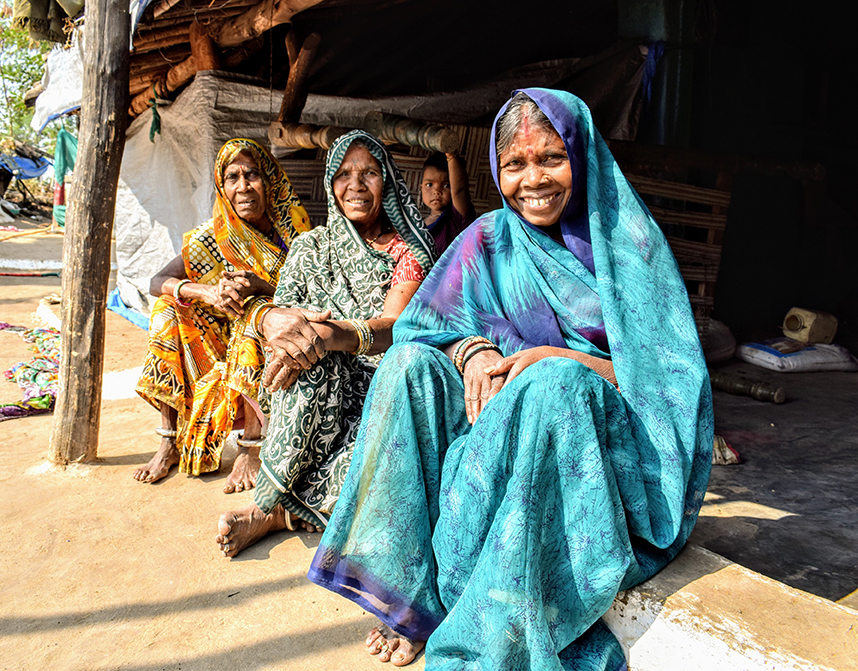3Fold Model: Wealthy, Resilient, and Responsible Farmers
Building wealth and resilience of smallholders through transformative livelihood solutions.
Source: Pallavi Saini, www.vrutti.org
1. The Challenge and the Opportunity:
When we talk of creating and sustaining millions of jobs in India, the potential of agriculture as a sector and smallholder farmers as a key constituency cannot be ignored. About 100 million1 smallholder farmers employ themselves on their farms, and provide employment to their own family members and a few other individuals. But, still most are poor. Every rupee invested, and invested effectively in smallholder agriculture and farmers has huge potential to not only make their enterprises thrive, but to potentially reduce poverty substantially. Then, where is the problem?
Smallholder agriculture in its current form is unviable; factors that limit it are virtually countless in number and variety. With the marginal landholding combined with poor soil quality, depleting water tables, and limited access to many inputs and services, it is difficult for small farmers to climb out of poverty with their existing portfolio. Entry into new commodities is fraught with production risk, market risk, and accessibility/cost of capital. The solutions that exist are in silos, including many of the large-scale government programs. The fragmented ecosystem is limiting the scale and sustenance of the support available to smallholders.
2. 3Fold: The Concept and Approach:
3Fold is about building wealthy, resilient, and responsible farmers -- making them successful entrepreneurs, sustained job creators, and increasing their income by 300 percent. It believes in the entrepreneurship orientation and potential of the farmers, and advancing the same to achieve the impact. It addresses the key gaps in the lack of integrated services (end-to-end) which is appropriate for the farmers, the need for diversified options (value add to farm and off-farm), augmented by integrators/activators at field level and technology, and the establishment of a sustainable ecosystem at a Cluster level, that enables collaborative actions for collective impact.

3Fold -- The Concept and Approach
Source: N Raghunathan, www.vrutti.org
The focus of the 3fold model is to enable the farmer to be an independent entrepreneur, by helping them acquire business and operational knowledge, and rebuild hope and trust. There are three parts to this Model:
- The journey of the farmer (and their families) in 3Fold starts with building a personal growth plan, followed by business planning for their enterprises, and potential diversification. To start with, it is done at the group level (farmer interest groups/village) and later to every individual farmer. Guided by the plan, customized capacity building, and mentoring support (farm advisory) is provided to every farmer. Accelerated and assured services with an integrated package that is farmer and enterprise focused is facilitated with partnerships (for access to seeds, inputs, agricultural machinery services; financial inclusion and access to capital; and access to markets). Opportunities to develop local entrepreneurs for inputs and services (such as farmers’ seed producers, custom hiring centers, bio-pesticides units, etc.) are exploited. Along with this, many schemes and entitlements from government for smallholder farmers are leveraged (particularly NREGS2, NFSM3, NABARD4, etc.).
- To aggregate products, deal with the markets, and sustain support, farmers’ interest groups, women enterprise groups, and farmer producer organizations are set up and they receive enterprise development support and linkages for undertaking group-based enterprises, produce aggregation for marketing, value addition enterprises, and market engagement. Through these group-based approaches, the scale for running enterprises, complementing skills, and dealing with markets are achieved. Accessing services and inputs at a lower cost and sharing risks enable entrepreneurs to take up these enterprises successfully. Moving towards value addition (processing) and marketing (B2B, B2C, B2G) are facilitated through multiple partnerships.
- While farmers and their groups initiate and continue their journey in an entrepreneurship mode, it is important that they are supported continuously (handholding, mentoring, advisory, and capacity building), along with exploring continuously opportunities from markets, the scientific community, and public investments. To enable this (to develop and support farmers and their institutions), Vrutti incubates clusters called Business Acceleration Units (BAUs) to establish a strong ecosystem in the agricultural sector so that farming enterprises in these clusters become sustainable and scalable -- institutions, technology, activators, and collaborators.

The Journey of the Farmer in 3Fold: The farmer’s journey with 3fold starts with onboarding where they will be attached to an activator and their support will begin.
Source: N Raghunathan, www.vrutti.org - Through these BAUs, Vrutti stays committed to enabling and empowering farmers on this journey, by owning the program with two key components of integration and dependencies to reduce risks and prevent minor issues from becoming larger problems. To deepen and accelerate impact, each BAU focuses on three to four key commodity chains (that have suitability to operate in the cluster and have market potential to increase incomes), and ensures that farmers, enterprise groups, and producer institutions move up in those commodity chains to maximize the share of consumer pie for themselves. In each BAU, the coverage starts with 1,250 farmers in the first year, reaching 2,500 farmers by the third year, and then accelerates to reach 10,000 farmers in the sixth year.
Overall, farmers access a bundle of services continuously on a sustained basis that are enabled through scientific methodologies (such as capital, market intelligence, and market linkages, access to seeds and inputs, capacity building, etc.). To achieve higher returns for the farmers, the model takes a commodity focus by working on three predominate commodities in each BAU.
The Impact
3Fold model expects the impacts in the following areas: income, resilience, environment, and institutions. Each BAU’s journey is for 10 years, with the incubation investment period of five years. By the end of five years, the BAU reaches 7,500 farmers (10,000 by year six), and establishes the farmers institutions, enterprises, and partnership appropriately augmented by technology and activators.
Apart from this, the resilience of the farmers improves substantially due to the diversified portfolio, better soil health, and water availability; the environment is improved with better water and soil utilization; and additionally, the farmers’ institutions and enterprises become viable and vibrant and create additional employment in the area. The details of these impacts are given in the picture above.
Given the underlying business model of the BAU and Farmer Producer Organizations (FPOs) becoming viable based on the value generated among the farmers, it is also expected that the value generated at each BAU level will be sufficient to take care of the annual operational and support costs, and in a 10-year timeframe of support, we expect that each BAU will also be able to provide a 10 percent funding return to seed a new BAU.
Proof of Concept
Vrutti has been working on this model and evolving it since 2010-11, in multiple locations with the support of a variety of organizations and its own resources. It started with the original model of covering 250 farmers directly by Vrutti, to a current level of coverage of about 2,500 or 10,000 farmers in each BAU level. In terms of the areas of support, Vrutti has tried out all the possible levers -- better package of practices, better varieties; financial services; commodity marketing, retail, and institutional markets for value added products; linking up with government services; FPO capacity building and financial linkages; insurance services, etc. The model has informed the process and evolved over the period. One of the key gaps that we found was that these services needed to be provided in every BAU location, under every activator so that every farmer gets access to all of these benefits based on their business plan. This is where the current model fits well, augmented by the technology (I Got Crops- developed by Mindtree.org5) and activators.
Works Cited
1 Estimates based on Highlights of Agriculture Census 2010-11 (Approximately 84% of 138 operational holdings comprise of small and marginal holdings) pib.nic.in
5 I GOT CROPS - Part of Mindtree.org - Digital Platform for Social Inclusion by http://mindtree.org/



